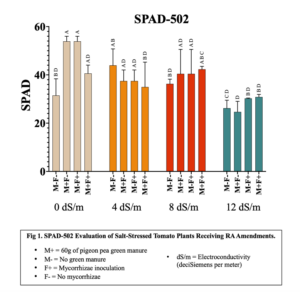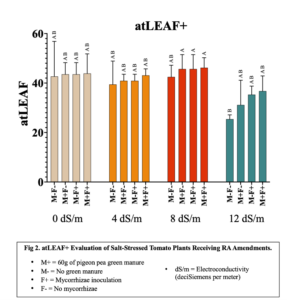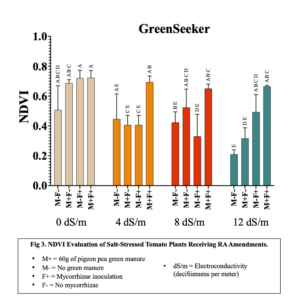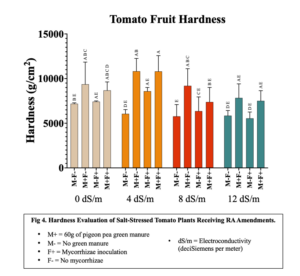Progress report for OS24-176
Project Information
The objective of this comprehensive investigation is to assess and validate the effectiveness of two regenerative agriculture (RA) methods-specifically, the implementation of a pigeon pea cover crop-green manure and the inoculation with the mycorrhizal species Glomus intraradices-in mitigating the effects of salt stress on two distinct tomato cultivars, Solanum lycopersicum cv. Tasti-Lee and Solanum lycopersicum cv. Sanibel. The rationale behind this research is rooted in the pressing need to address the escalating challenges posed by soil salinity in Florida, a critical concern for tomato production.
As tomatoes represent a cornerstone of Florida's agricultural economy, it is imperative to develop sustainable solutions that can fortify the resilience of tomato crops against the burgeoning threats of saline stress. The chosen cultivars, Tasti-Lee and Sanibel, provide an intriguing comparative platform. Tasti-Lee, renowned for its adaptability to Floridian conditions, is anticipated to exhibit robust vigor in the face of saline challenges. On the other hand, the relatively understudied Sanibel variety presents an intriguing prospect, as its response to salt stress is not well-documented. It is plausible that Sanibel may manifest comparable or even superior growth and yield results under saline conditions.
The innovative aspect of this proposed solution lies in the combined treatment strategy, leveraging both the pigeon pea cover crop-green manure and mycorrhizal inoculation. We hypothesize that this synergistic approach will yield the most substantial positive impacts on the growth and crop yield of both Tasti-Lee and Sanibel cultivars when subjected to salt stress. If our hypothesis proves correct, this dual application of regenerative agricultural practices would emerge as a potent and cost-effective resource for farmers and gardeners, regardless of the scale of their operations, who grapple with salinity challenges in their fields.
The primary focus of our investigation is to provide empirical evidence supporting the efficacy of these RA methods as sustainable and practical solutions for salt-stressed tomato cultivation. The experiment will be conducted under controlled conditions, systematically manipulating saltwater stress levels, and meticulously monitoring the response of each cultivar to the designated treatments. The outcomes of this research hold the promise of not only enhancing the salt tolerance of tomatoes but also contributing valuable insights that can be extrapolated to other crops facing similar challenges in saline-prone regions.
The first RA method under scrutiny involves the incorporation of a pigeon pea cover crop, which will serve a dual purpose as both a cover crop and green manure. Pigeon pea cover crops have demonstrated efficacy in weed control, nutrient retention, and soil moisture conservation (Benedict et al., 2014; Sharma et al., 2018). As a green manure, the cover crop can be plowed into the soil, enriching it with organic material and enhancing nutrient availability (Finney et al., 2017). By investigating the impact of pigeon pea cover crop-green manure on the two tomato cultivars, we aim to elucidate its potential role in ameliorating salt stress and improving overall crop health and productivity.
The second RA method involves the introduction of the mycorrhizal species Glomus intraradices to the tomato root system. Arbuscular mycorrhizal fungi (AMF) have been acknowledged for their positive influence on plant health and performance under stress conditions (Ruiz-Lozano et al., 2012; Selvakumar et al., 2014). AMF form symbiotic relationships with plant roots, enhancing mineral acquisition and aiding in the regulation of ion osmotic potential. By exploring the impact of G. intraradices on the two tomato cultivars, we seek to unravel the potential of mycorrhizal inoculation as a targeted strategy for mitigating salt stress effects, thereby bolstering the resilience of tomatoes to adverse environmental conditions.
The combined application of these RA methods aims to create a holistic and sustainable approach to salt stress mitigation in tomato cultivation. By synergistically leveraging the benefits of cover cropping and mycorrhizal inoculation, we anticipate observing enhanced plant vigor, improved physiological responses, and ultimately increased crop yield under saline conditions. The robustness of this dual strategy lies in its potential to offer a comprehensive solution that addresses multiple facets of salt stress, from soil health to plant physiology.
The significance of this research extends beyond the laboratory, reaching into the practical realm of agriculture. If our hypothesis is substantiated, the proposed RA methods could emerge as accessible and economically viable tools for farmers and gardeners grappling with salinity challenges in their fields. The scalability and cost-effectiveness of these methods make them particularly appealing for both large-scale agricultural enterprises and smaller, community-based initiatives. This aligns with the broader goal of regenerative agriculture, which emphasizes sustainable practices that not only enhance productivity but also contribute to the long-term health and resilience of agricultural ecosystems.
This research endeavors to contribute substantively to the ongoing efforts to address the escalating challenges of salt stress in Florida's tomato production. By focusing on the Tasti-Lee and Sanibel cultivars and employing a dual RA approach, we aspire to provide empirical evidence that supports the practical implementation of these regenerative agricultural methods. The potential benefits extend beyond the specific tomato cultivars under investigation, with implications for the broader agricultural landscape facing similar challenges. Ultimately, the success of this proposed solution would mark a significant step toward building sustainable and resilient agricultural practices in the face of evolving environmental threats.
Phase 1: Growth Chamber/Lab Component:
The initial phase of this study comprises two critical components: Seed ecophysiology assessment under saline stress and field crop performance under saline stress.
Seed Ecophysiology Assessment:
Seed germination and vigor tests will be conducted using three repetitions of 50 seeds from two tomato cultivars. The seeds will be incubated in petri dishes containing towelettes moistened with 0, 2, 4, and 6‰ NaCl solutions. Germination rates will be recorded at 7 and 14 days, and measurements of emerging hypocotyls and epicotyls will be obtained.
To evaluate stress-related nutrient loss, seeds will undergo incubation with the same salinity treatments for 6 and 24 hours. Following this, the seeds will be washed, submerged in 50 mL distilled water, and the water medium will be tested using nutrient ion sensors for N, P, K, Ca, and Mg concentrations, along with electrical conductivity sensors to assess overall ion loss.
In order to observe stress-related moisture loss, seeds will be subjected to the petri dish method for 6 and 24 hours. Afterward, the seeds will be weighed, dehydrated, and reweighed. The difference in wet and dry weights will reveal seed moistures corresponding to each salinity treatment.
Phase 2: Field Crop Component:
The field crop component involves several key steps:
- Soil Preparation with Green Manure:
- Each tomato cultivar group (Tasti-Lee and Sanibel) will undergo initial soil preparation with green manure in 120 pots.
- Nitrogen-fixing pigeon pea (Cajanus cajan) will be inoculated with Bradyrhizobium sp. (Pro-Mix BX Mycorrhizae, Premier Tech, Pennsylvania, US) and grown for three months before being mulched into the soil.
- This will result in three soil media treatments: 4 pigeon pea plants per pot, 2 pigeon pea plants per pot, and no pigeon pea plants per pot.
- Tomato Season Step:
- Following soil preparation, the tomato season step will commence, with tomato seeds planted for the Fall 2023 season.
- Salinity Treatments:
- Within each soil group, four sets of salinity solutions (6‰ NaCl, 4‰ NaCl, 2‰ NaCl, and distilled water) will be applied at five repetitions each.
- Mycorrhizal Inoculation:
- Across all soil media and salinity groups, half of the tomatoes will be inoculated with the beneficial mycorrhizal species Glomus intraradices (Pro-Mix BX Mycorrhizae, Premier Tech, Pennsylvania, US); the remaining half will remain uninoculated.
- Physical Leaf Measurements:
- Leaf area changes will be measured every two weeks.
- Histological samples for stomatal morphology will be obtained biweekly.
- NDVI, SPAD, and atLEAF measurements will be taken for assessing photosynthetic activity and chlorophyll content.
Phase 3: Market and Taste Assessments:
- Physical Measurements of Fruits:
- Fruit measurements will include yield per plant, size of fruit, and firmness determined via penetrometer.
- Chemical Tests of Fruit Samples:
- DPPH and FRAP assays will be conducted to assess antioxidant content.
- RP-HPLC and mass spectrometry readings will be performed to quantify sugar, lycopene, and organic acid content.
- Chemical Testing of Pot Soil:
- Salinity, electrical conductivity, pH, and N, P, K, and micronutrient readings will be measured every two weeks using laboratory pH meters and manual ionic sensors.
- Taste Panels:
- Taste panels with focus groups will be organized through the FIU Biscayne Bay campus’ Hospitality Management program. Tomatoes will be scored based on sour and sweet flavors.
Cooperators
- (Educator and Researcher)
- (Researcher)
- - Producer
Research
This project includes two tomato growth trials with crops subjected to varying levels of salt stress, with green manure and mycorrhizae inoculation as ameliorative treatments. One trial has been conducted within a greenhouse setting, and another in a field farmland setting will be conducted in Summer-Fall 2025. Statistical analysis of preliminary data consisted of a multivariate analysis of variance performed using GraphPad Prism statistics software.
Media Preparation, Treatment Administration, and Tomato Planting
Prior to planting of tomato seeds, pigeon pea plants were cultivated from seed in 3-gallon pots with substrate composed of 37.5% pine bark, 30.0% coir pith, 25% perlite, and 7.5% sand. This soil makeup provides a slightly acidic and well-drained substrate appropriate for tomato cultivation. Pigeon peas were planted as seeds mixed with Bradyrhizobium inoculant media and grown until just prior to flowering stage, at which point they were mixed into the soil as a green manure (GM) (one treatment comprised 60 grams of GM, the other was a control treatment lacking GM). Root samples were harvested for bacterial colony extraction and plating, after which colony PCR and Sanger sequencing were performed for confirmation of inoculation. Following GM mixture into soil, tomato seeds were planted into the pots such that each pot contained one tomato specimen. Those selected for mycorrhizal inoculation treatment received inoculant at the time of planting, with the inoculant substrate mixed into the soil at the region of seed planting.
Ecophysiological Characteristics
Two weeks following germination, monthly measurements commenced. Photosynthetic and stomatal conductance behavior were analyzed using the following optical sensors: GreenSeekerTM, atLEAF+, SPAD-502, and LI-COR® LI-600. The SPAD-502 meter provides a light absorbance-based assessment of chlorophyll content, with the atLEAF+ sensor serving as a relatively budget-friendly alternative with which to compare data readings for accuracy distinctions. The GreenSeeker utilizes a canopy light reflectance NDVI reading, thus offering a different strategy for determining photosynthetic activity. LI-600 provides detection of chlorophyll a fluorescence (a reading which more directly assesses chlorophyll molecule excitation compared to the chlorophyll-containing tissue reflectance readings of SPAD-502 and atLEAF+). It also yields detection of stomatal conductance, an important parameter which elucidates drought-related behavioral changes in foliar tissues. Flower and tomato fruit counts were conducted upon first emergence. Soil leachate samples were acquired by saturating tomato pots with distilled or reverse-osmosis water, followed by a standby period of 10 minutes after which an additional liter of water was delivered to the soil; the resulting runoff was collected and analyzed for ionic contents using portable sensors for the following parameters: NO3-, NH4+, Ca2+, K+, Na+, electrical conductivity (EC), salt concentration, and pH.
Post-Harvest Analysis
Upon fruit harvesting, leaf tissue samples was acquired for mineral content analysis; leaves will were dried and ground into powder prior to mineral analysis. A final fruit count was performed, average fruit diameter was calculated using caliper measurements across four sides of each fruit, and fruit weights were obtained. Fruit color parameters were taken using a portable colorimeter. Textural quality was determined with the use of a penetrometer, with analyzed parameters including hardness, fracturability, cohesiveness, springiness, chewiness, and resilience. Hardness refers to the peak force needed for the first penetrometer compression into the fruit. Fracturability, if it occurs, refers to the fall-off of penetrometer force at the moment the fruit ruptures under compression. Cohesiveness informs how well the fruit withstands the second compressive deformation relative to its resistance against the first compression. Springiness denotes the degree of fruit spring back after its first compressive deformation and the wait time until the second penetrometer downstroke. Chewiness is comprised of the fruit’s hardness × its cohesiveness × its springiness and translates into the elastic resistance of the fruit during mastication. Resilience refers to how hard the fruit fights to regain its original height following its first decompression and is detected during the first penetrometer probe withdrawal. Hardness, fracturability, springiness, and resilience provide parameters important for assessing shipping quality of fruits, and all of these parameters inform consumptive quality and can serve as useful comparisons to taste panel results. Following all physical measurements, fruit tissues were homogenized and filtered for extract collection. Extract total soluble solids were assessed using a refractometer. Sample acidity was determined using a pH sensor. Extract viscosity was analyzed through the use of a viscometer.
Precision Agriculture Optical Sensors
Across control salinity treatments, SPAD-502 measurements revealed significantly greater chlorophyll readings in tomatoes receiving only green manure or only mycorrhizae inoculation, while those receiving both yielded results comparable with control plants (no GM or mycorrhizae) (Figure 1). In plants subjected to all other salinity conditions, no significant differences were observed across all amendment combinations. atLEAF+ results found no significant differences within salinity treatments, although plants undergoing the highest salinity condition with no RA amendments yielded significantly lower chlorophyll readings compared to RA amendment-receiving plants treated with 8 dS/m irrigation water (Figure 2). However, a number of distinctions are observed in GreenSeeker readings across treatment groups (Figure 3). Firstly, in plants undergoing irrigation with 4 dS/m water, those receiving a combined GM-mycorrhizae amendment yielded greater NDVI results compared to those receiving only GM or only mycorrhizae. Within the 8 dS/m irrigation group, plants receiving the combined GM-mycorrhizae treatment had greater NDVI compared with those receiving only mycorrhizae. Finally, in the 12 dS/m group, plants receiving only mycorrhizae and those provided with the combined amendment treatment had greater NDVI results compared with the control plants and those receiving only GM.
Tomato Fruit Texture Evaluation
With respect to fruit hardness, some distinctions are also observed (Figure 4). In the 4 dS/m salinity group, plants receiving the combined RA amendment and those receiving only mycorrhizae maintained fruit hardness levels greater than those of control groups, while in the 8 dS/m salinity group those receiving only mycorrhizae yielded higher fruit hardness compared to controls. No significant differences were observed between the treatments in the 12 dS/m salinity group.
Discussion
SPAD-502 and atLEAF+ values revealed a comparable trend wherein chlorophyll content is maintained across our salinity gradient until the highest salinity treatment of 12 dS/m, upon which significant drops in chlorophyll are observed. However, NDVI assessment appears to display further sensitivity between RA amendment strategies across different salinity groups. Whereas no SPAD-502 and atLEAF+ value differences are observed between RA amendment groups in the 4 dS/m and 8 dS/m salinity groups, GreenSeeker results do reveal differences between amendment treatments. In the 4 dS/m and 8 dS/m group, SPAD and atLEAF+ do not show any notable differences between amendment treatments, whereas GreenSeeker measurements indicate significantly higher results for the combined GM-mycorrhizae amendment in the 4 dS/m group and higher combined and GM-only amendments over the mycorrhizae-only amendment in the 8 dS/m group. Additionally, in the 12 dS/m group, while no discernable differences are noted between amendment treatments, distinctions are observed among them using the GreenSeeker. These differences in chlorophyll assessment may be the result of the fundamentally different optical strategies utilized by the absorbance-based (SPAD-502 and atLEAF+) and reflectance-based (GreenSeeker) instruments; the NDVI values are obtained by monitoring a plant’s entire canopy, providing an immediate holistic evaluation of the plant’s foliar tissues, while instruments such as SPAD-502 and atLEAF+ rely on individual leaf detection using clamping or aperture-insertion methods. Consequently, there is more room for sampling errors with the absorbance meters, in which certain outlier leaves can skew results and provide an inaccurate assessment of the overall plant. This error is minimized in the canopy-wide evaluation made possible by an overhead NDVI reader such as GreenSeeker.
Fruit texture quality results indicate that RA amendments provide enhanced resistance to salinity stress. While all amendment treatments in the control salinity group show no difference in fruit hardness results, differences between plants receiving no amendments and those which receive amendments begin to develop in the 4 dS/m and 8 dS/m salinity groups. Enhancements in parameters such as fruit hardness are important for the purposes of shipping and handling, as fruits with greater textural quality are better equipped to sustain the stresses of packaging and relocation without undergoing damage. In the highest salinity group, no advantages are observed between amendment groups, indicating the passing of a salinity stress threshold beyond which RA amendments fail to rescue fruit texture quality. Thus, while GreenSeeker chlorophyll readings show significantly greater results in combined GM-mycorrhizae and mycorrhizae-only readings compared to plants lacking amendments, these observations do not correlate with enhanced texture quality in fruits derived from these plants at such high salinity conditions.
Conclusions
While such results are preliminary, they suggest benefits in the application of RA amendments such as GM and mycorrhizae inoculation, both in isolation and in combination. Further investigation is required to elucidate physiological and genetic responses to these applications under distinct salinity pressures. However, the presence of notable improvements in both foliar chlorophyll content and fruit texture quality indicate that further investigation into these amendments is a worthwhile pursuit for this dissertation study.
Educational & Outreach Activities
Participation Summary:
FIU's flagship Farmers Outreach Program for the Veterans, Youth and Special Need Agriculturists Assistance Program (referred to as the Farmers Outreach Program) aims to empower small and under-represented farmers in urban sustainable agriculture, as well as beginning farmers who are interested in starting their own business. This program is predominantly geared towards assisting veterans, small farmers, minorities, and the socially disadvantaged by offering hands-on farming experience through apprenticeships, agricultural-related workshops, and technical one-on-one advice on USDA loans/grant programs. We have collaborated with several farms, nurseries, and organizations throughout South Florida to provide this engaging and practical learning experience. The PI of the program is a co-PI in this project as well and the successful experiences will be used in this project.
The success and impact of our research extend beyond the laboratory and into the hands of those who can implement and benefit from our findings. The outreach plan for the project "Regenerative Agriculture: Effects of Cover Crop and Mycorrhizal Inoculation on Salt Stress Mitigation in Floridian Tomato Cultivars" is designed to engage various stakeholders, including farmers, agricultural professionals, educators, and the broader community. Our approach encompasses a diverse range of outreach activities to ensure effective knowledge dissemination and practical application of the research outcomes.
- Workshops and Field Days: Conducting hands-on workshops and field days will be a primary component of our outreach plan. These events will provide a platform for farmers and agricultural practitioners to learn about the regenerative agriculture techniques studied in the project. Participants will have the opportunity to observe cover cropping and mycorrhizal inoculation in action, ask questions, and receive guidance on implementing these practices in their own operations. Workshops will be conducted at FIU Organic Garden (USDA Designated People’s Garden) and at the Little Farm. Special effort will be made to invite small and under-served farmers in Miami Dade county. 2. On-Farm Demonstrations: Collaborating with local farms to establish on-farm demonstrations will be a powerful tool for showcasing the practical application of regenerative agriculture techniques. These demonstrations will serve as living examples, allowing farmers to witness the positive effects of cover crops and mycorrhizal inoculation on salt stress mitigation in tomato cultivars. By partnering with local growers, we can demonstrate the scalability and adaptability of these methods in real-world farming scenarios. 3. Farmer Training Programs: Developing comprehensive farmer training programs will be crucial for fostering the adoption of regenerative agriculture practices. These programs will include both in-person and online modules, covering topics such as cover crop selection, mycorrhizal inoculation techniques, and the integration of these practices into existing farming systems. By empowering farmers with the knowledge and skills needed for successful implementation, we aim to facilitate widespread adoption. 4. Videos and Webinars: Producing engaging and informative videos and webinars will be an integral part of our outreach strategy. These multimedia resources will highlight the key findings of the project, showcase success stories from farmers who have adopted regenerative practices, and provide step-by-step guides for implementation. This approach ensures that the information is not only accessible but also visually compelling, enhancing knowledge retention. 5. Educational/Extension Publications: Publishing articles in agricultural open access journals and creating educational publications will be essential for reaching a broader stakeholder. These publications will detail the methodology, results, and practical implications of the research, contributing to educating the farmers. Additionally, we will produce farmer-friendly guides and pamphlets that distill the research into actionable insights for practitioners. 6. Presentations at Meetings and Conferences: Participating in regional and national SARE and ASHS annual meetings and conferences will allow us to share our research with a diverse audience of researchers, policymakers, and industry professionals. Presentations will cover the project's objectives, methodologies, and key findings, fostering collaboration and knowledge exchange within the broader agricultural community.
Learning Outcomes
Soil amendments
Handheld optical sensors for monitoring the plant health
Project Outcomes
We have completed the greenhouse and lab portion of the project and will conduct the field portion during the Fall and Spring seasons. To assess the impact of regenerative agriculture techniques on agricultural sustainability, we have developed a survey evaluating the likelihood of vegetable producers adopting these practices for tomato crops, particularly in response to climate change. After obtaining IRB certification, the survey was reviewed and refined with input from the UF/IFAS Miami Dade Vegetable Extension Agent and will be distributed to farmers before the summer.
The field trials will provide firsthand insights into the economic, environmental, and social benefits of regenerative agriculture. To further engage the farming community, we plan to invite farmers to visit the trial plots, allowing them to observe the practical applications and potential advantages of these methods. By integrating scientific research with stakeholder input, this project aims to enhance the sustainability of vegetable production through informed decision-making and increased adoption of climate-resilient agricultural practices.
We will complete this section after the completion of the project.
Information Products
- Survey on the utility of regenerative agriculture techniques in addressing climate change for tomato crops
- Impact of Regenerative Agriculture on Mitigation Salt Stress in Tomato Cultivars Within Urban Miami
- Studying the Efficacy of Bradyrhizobium Colonization in Pigeon Pea Cover
- Seeds and Climate Change
- Effectiveness of precision agriculture technology for urban agriculture and efficient food production
- History of tomato cultivation and its future with the progression of climate change
- Testing the Effects of Two Regenerative Agriculture Techniques on Salt StressAmelioration in Tomato Crops
- Seeds for New Worlds: From Climate Change on Earth to Agriculture on Mars



